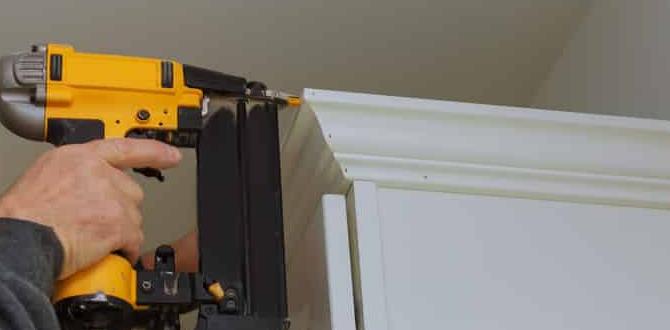Quick Summary: If your nail gun trigger is stuck, it’s likely due to a simple obstruction or lack of lubrication. Follow these easy steps: clear debris, check the safety mechanism, lubricate moving parts, and gently tap the trigger. If issues persist, inspect the air line or internal components. Addressing a stuck trigger quickly ensures safe and efficient project completion.
Hey there, fellow DIYers! Jack Shaffer here, your go-to guy for all things nail guns and woodworking. We all love the power and efficiency a nail gun brings to a project, but there’s nothing more frustrating than pulling the trigger and… nothing happens. A stuck trigger can bring your project to a screeching halt and leave you scratching your head. But don’t worry! This is a super common issue, and usually, it’s something you can fix yourself with a few simple steps. I’ve seen it countless times in my workshop, and the good news is, it’s rarely a major problem. We’re going to walk through some genius solutions that will get your nail gun firing again in no time. Ready to get back to building? Let’s dive in!
Table of Contents
Why Does My Nail Gun Trigger Get Stuck?
It’s a question many of us have asked ourselves, usually when we’re halfway through a project and on a tight deadline. A stuck trigger can happen for a few reasons, and understanding these will help us fix it. The most common culprits are usually quite straightforward:
- Debris and Dust: Wood shavings, sawdust, or small bits of material can get lodged in the trigger mechanism. Over time, this can build up and prevent the trigger from moving freely. Think of it like a tiny pebble in a hinge – it stops the whole thing from working smoothly.
- Lack of Lubrication: Like any moving part, the trigger mechanism needs a little lubrication to operate without sticking. Without it, metal parts can rub against each other, creating friction and eventually leading to a stuck trigger. Even a dry spring can feel sluggish.
- Misaligned Safety Tip: Most nail guns have a safety mechanism on the nose, often called a contact tip or firing pin. If this gets jammed or isn’t fully retracted, it can prevent the trigger from being activated. It’s designed for safety, but sometimes it needs a little nudge.
- Internal Component Issues: Less common, but still possible, are issues with internal springs, O-rings, or other small parts within the trigger assembly itself. These might be worn out, damaged, or out of place.
- Air Pressure Problems: For pneumatic nail guns, incorrect air pressure can sometimes affect the trigger’s responsiveness. If the pressure is too low, the mechanism might not have enough force to reset properly.
The beauty of most nail gun designs is their robustness. They’re built to withstand tough work environments. However, this also means that minor obstructions are often the easiest fix. We’ll focus on the most common and easily resolvable issues first, so you can get back to your project with confidence.
Before You Start: Safety First!
Before we even think about touching that trigger, safety is our absolute number one priority. A nail gun is a powerful tool, and a stuck trigger can sometimes be a sign of something that needs careful attention. Never, ever point a nail gun at yourself or anyone else, even when you think it’s not working.
Here’s what you must do before any troubleshooting:
- Disconnect the Power Source:
- For pneumatic (air-powered) nail guns: Completely disconnect the air hose from the nail gun. Ensure the air compressor is turned off.
- For cordless (battery-powered) nail guns: Remove the battery pack.
- For corded electric nail guns: Unplug the power cord from the electrical outlet.
- Remove All Fasteners: If possible, unload any nails or staples from the nail magazine. This prevents accidental firing during troubleshooting.
- Wear Safety Glasses: Always protect your eyes. Even a small spring or piece of debris could fly out unexpectedly.
Taking these precautions ensures that your troubleshooting session is safe and that you won’t have any surprising nail-gun incidents. We want to fix the problem, not create a new one!
The Genius Solution: Step-by-Step Guide to Fixing a Stuck Nail Gun Trigger
Alright, with safety covered, let’s get to it! This guide will take you through the most common fixes. We’ll start with the simplest, as often the solution is surprisingly easy.
Step 1: Inspect and Clear External Debris
This is the most frequent cause of a stuck trigger – good ol’ dirt and grime. Take a good look at the trigger area and the nose of the nail gun.
- Visual Inspection: Look closely around the trigger itself, the trigger guard, and the contact tip (the part that touches the wood). Can you see any visible dust, wood chips, or other foreign materials?
- Gentle Blowing: Use a can of compressed air (the kind you use for cleaning keyboards) to blow out any loose debris from the trigger area and around the nose. Hold the can upright and use short bursts.
- Soft Brush: If compressed air isn’t enough, use a clean, soft brush (like a paintbrush or toothbrush) to gently dislodge any stuck-on debris. Work the bristles around the trigger pivot point and the safety tip.
- Wipe Down: Use a clean, dry cloth to wipe down the exterior of the nail gun, paying special attention to the trigger and nose area.
Sometimes, just removing a tiny piece of sawdust is all it takes! Give the trigger a try after this step. If it moves freely, congratulations! You’ve fixed it. If not, proceed to the next step.
Step 2: Check the Safety Mechanism (Contact Tip/Nose)
The trigger is often interlinked with the safety tip. If the tip isn’t retracting properly, the trigger won’t fire. This ensures you don’t accidentally shoot a nail when you’re not actively pressing the gun against a surface.
- Press the Nose: With the nail gun disconnected from power, firmly press the nose (the contact tip) of the nail gun against a solid, sturdy surface like a workbench or a piece of scrap wood. You should hear and feel a “click” or a slight movement.
- Wiggle and Press: Gently wiggle the contact tip while pressing it. Sometimes, a bit of grit can prevent it from depressing fully. Feel for any resistance.
- Inspect the Firing Pin: Look at the very end of the nose where the nail is supposed to come out. There’s often a “foot” or “plunger” that needs to be pushed in. Ensure this isn’t jammed or stuck in the extended position.
- Clear the Opening: If you see any debris around the firing pin area, use your soft brush or compressed air again to clear it out.
After ensuring the safety tip can depress and retract smoothly, test the trigger again. If it still feels stuck, we move on.
Step 3: Lubricate the Trigger Mechanism
Lack of lubrication is a common cause of sticky or stuck triggers, especially in drier climates or after periods of disuse. A little oil can go a long way.
- Choose the Right Lubricant: For most pneumatic nailers, a few drops of specialized pneumatic tool oil or even a light-grade machine oil (like 3-in-1 oil) is sufficient. For electric or battery models, a silicone-based lubricant or a dry lubricant might be better to avoid gumming up electrical components. Always check your tool’s manual if you have it!
- Locate Zerk/Oil Ports (Pneumatic): Many pneumatic tools have small grease fittings (zerks) or oil ports specifically for lubrication. Check the body of the nail gun, often near air inlet or moving parts. If yours has them, use a grease gun with appropriate grease or apply a few drops of oil.
- Apply to Trigger Pivot: Even without specific ports, you can usually apply a tiny amount of oil directly to the pivot point of the trigger. Find where the trigger connects to the main body of the gun.
- Work It In: After applying a drop or two of lubricant, gently rock the trigger back and forth many times. This helps the oil spread evenly throughout the mechanism.
- Wipe Excess: Use a clean cloth to wipe away any excess lubricant. You don’t want it dripping everywhere.
Give the trigger a good series of actuations after lubricating. If you feel it start to move more freely, that’s a great sign. If it’s still seized, don’t force it!
Step 4: Gentle Tapping and Vibration (Use Sparingly!)
If the trigger is firmly stuck and won’t budge even after cleaning and lubrication, sometimes a gentle tap can help dislodge a slightly jammed component. This should be a last resort before considering deeper disassembly.
- Use a Rubber Mallet or Soft Object: Never use a metal hammer directly on your tool. If you have a rubber mallet, that’s ideal. If not, you can use the handle of a screwdriver or a block of wood to cushion the impact.
- Tap Around the Trigger Area: With the tool still disconnected from power, gently tap around the trigger housing and the surrounding area. You’re not trying to break anything; you’re just applying a small shock to potentially free up a stuck spring or lever.
- Tap the Nose: You can also try very light taps on the nose assembly.
- Be Patient: Try this with moderate force. If the trigger doesn’t move after a few gentle taps, stop. Forcing it can cause damage.
If the tapping helped even a little, try working the trigger gently again. If it moves freely, you’ve likely freed a minor internal jam. If it’s still completely stuck, it’s time to consider the next steps.
Step 5: Check the Air Line and Pressure (Pneumatic Nailers)
For air-powered nail guns, the issue might not be with the gun itself but with the air supply.
- Verify Air Hose Connection: Ensure the air hose is securely connected to both the compressor and the nail gun. A loose connection can lead to insufficient air pressure.
- Check Compressor Pressure: Look at the pressure gauge on your air compressor. For most framing and finishing nailers, a pressure setting between 70-120 PSI is standard. Consult your nail gun’s manual for the recommended range. Ensure the compressor is actually supplying that pressure.
- Test with Another Tool: If you have another pneumatic tool, try connecting it to the same air line. If that tool works fine, the problem is more likely with your nail gun. If the other tool also has issues, the problem might be with your hose or compressor.
- Inspect the Coupler: The quick-connect coupler on the end of your air hose can sometimes get clogged or damaged, restricting airflow. Clean it out or replace it if necessary.
Low or inconsistent air pressure can cause various issues, including a trigger that doesn’t reset properly or feels sluggish. Getting this right is crucial for many nail gun functions, not just the trigger.
Step 6: Inspect Internal Components (Advanced/If Comfortable)
If you’ve gone through all the previous steps and your trigger is still stuck, it’s possible there’s an issue with the internal trigger assembly. This step involves slightly more advanced work and should only be attempted if you are comfortable with basic tool disassembly.
Important: Always refer to your specific nail gun’s manual for disassembly instructions. Some models are much easier to take apart than others. If you’re not comfortable, it’s best to take it to a professional service center.
- Consult Your Manual: Find the parts diagram and disassembly guide for your nail gun model. This is invaluable.
- Remove Housing/Cover Screws: Typically, there are a few screws on the body of the nail gun that allow you to access the trigger mechanism. Carefully remove these.
- Keep Track of Parts: As you remove screws and parts, lay them out in order on a clean surface, or take pictures as you go. Small springs and pins can easily get lost.
- Examine Trigger Lever and Springs: Look for any bent or broken springs, misaligned levers, or obstructions inside the trigger housing.
- Clean and Re-lubricate: Clean any visible grime from the internal parts. Apply a small amount of appropriate lubricant to the trigger lever and any associated moving components.
- Reassemble Carefully: Put everything back together in the reverse order you took it apart. Ensure all springs and pins are seated correctly.
If you find a broken part, such as a spring, you’ll likely need to order a replacement part specific to your nail gun model. Websites like eReplacementParts.com or the manufacturer’s own parts store are excellent resources for sourcing genuine replacement parts.
Troubleshooting Table: Common Stuck Trigger Scenarios
Here’s a quick reference table to help you diagnose the problem based on symptoms:
| Symptom | Likely Cause | Solution Steps |
|---|---|---|
| Trigger feels stiff but moves slightly. | Minor debris or lack of lubrication. | Step 1 (Clean), Step 3 (Lubricate). |
| Trigger is completely stuck and won’t move at all. | Significant debris, jammed safety tip, or internal component jam. | Step 1 (Thorough Clean), Step 2 (Safety Tip), Step 4 (Gentle Tap), Step 6 (Internal Inspection) if necessary. |
| Trigger moves but doesn’t fire nail. | Safety tip not fully depressed, low air pressure (pneumatic), or internal firing mechanism issue. | Step 2 (Safety Tip), Step 5 (Air Pressure), Step 6 (Internal Inspection). |
| Trigger feels mushy or weak. | Low air pressure (pneumatic) or a weak/damaged return spring. | Step 5 (Air Pressure), Step 6 (Internal Inspection for spring). |
When to Call a Professional
While most nail gun trigger issues are DIY-friendly, there are times when it’s best to seek expert help. If you’ve tried all the steps above and the trigger is still stuck, or if you’ve taken the tool apart and can’t figure out how to reassemble it, don’t hesitate to reach out.
- If You Find Broken Parts: If you discover a visibly broken spring, lever, or housing during disassembly, and you’re not comfortable sourcing and replacing it yourself.
- If You’re Unsure About Disassembly: Some nail guns have complex internal mechanisms. Forcing parts or reassembling them incorrectly can cause more damage.
- If the Tool is Under Warranty: Attempting repairs yourself might void your warranty. Check your warranty information before disassembling.
- Persistent Problems: If you’ve fixed it before, and it keeps happening, there might be a more significant underlying issue.
Your local tool repair shop or the manufacturer’s service center can often diagnose and fix these issues efficiently. Remember, sometimes investing in a professional repair is more cost-effective than buying a new tool.
Frequently Asked Questions (FAQ)
Q1: Can I use WD-40 to fix a stuck trigger?
A: While WD-40 can help free up a temporarily stuck mechanism by acting as a solvent, it’s not recommended as a long-term lubricant for nail guns. It can attract dust and may evaporate relatively quickly, leaving parts dry again. It’s better to use specialized pneumatic tool oil for air nailers or a silicone-based lubricant for others. Use WD-40 sparingly, primarily for cleaning, and follow up with proper lubrication.
Q2: My nail gun is brand new and the trigger is stuck. What should I do?
A: If a brand new nail gun has a stuck trigger, do not attempt disassembly. This almost certainly indicates a manufacturing defect. The best course of action is to contact the retailer or manufacturer immediately to arrange for a return, exchange, or warranty repair. It’s frustrating, but it’s covered!
Q3: How often should I lubricate my nail gun?
A: For pneumatic nail guns, it’s generally recommended to apply a few drops of oil at the beginning of each day’s use or after about 1-2 hours of continuous operation. Some nailers also require periodic greasing of specific components. For cordless and electric nailers, lubrication needs are usually much less frequent, often only when you disassemble for cleaning or if you notice sticking. Always check your tool’s manual for the manufacturer’s specific recommendations.
<h3


